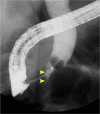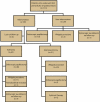Performance characteristics of EUS for locoregional evaluation of ampullary lesions
- PMID: 25293823
- PMCID: PMC4322681
- DOI: 10.1016/j.gie.2014.08.005
Performance characteristics of EUS for locoregional evaluation of ampullary lesions
Abstract
Background: The accuracy of EUS in the locoregional assessment of ampullary lesions is unclear.
Objectives: To compare EUS with ERCP and surgical pathology for the evaluation of intraductal extension and local staging of ampullary lesions.
Design: Retrospective cohort study.
Setting: Tertiary-care referral center.
Patients: All patients who underwent EUS primarily for the evaluation of an ampullary lesion between 1998 and 2012.
Intervention: EUS.
Main outcome measurements: Comparison of EUS sensitivity/specificity for intraductal and local extension with ERCP and surgical pathology by using the area under the receiver-operating characteristic (AUROC) curves and outcomes of the subgroup referred for endoscopic papillectomy.
Results: We identified 119 patients who underwent EUS for an ampullary lesion, of whom 99 (83%) had an adenoma or adenocarcinoma. Compared with ERCP (n = 90), the sensitivity/specificity of EUS for any intraductal extension was 56%/97% (AUROC = 0.77; 95% confidence interval [CI], 0.64-0.89). However, when using surgical pathology as the reference (n = 102), the sensitivity/specificity of EUS (80%/93%; AUROC = 0.87; 95% CI, 0.76-0.97) and ERCP (83%/93%; AUROC = 0.88; 95% CI, 0.77-0.99) were comparable. The overall accuracy of EUS for local staging was 90%. Of 58 patients referred for endoscopic papillectomy, complete resection was achieved in 53 (91%); in those having intraductal extension by EUS or ERCP, complete resection was achieved in 4 of 5 (80%) and 4 of 7 (57%), respectively.
Limitation: Retrospective design.
Conclusions: EUS and ERCP perform similarly in evaluating intraductal extension of ampullary adenomas. Additionally, EUS is accurate in T-staging ampullary adenocarcinomas. Future prospective studies should evaluate whether EUS can identify characteristics of ampullary lesions that appropriately direct patients to endoscopic or surgical resection.
Copyright © 2015 American Society for Gastrointestinal Endoscopy. Published by Elsevier Inc. All rights reserved.
Figures
Comment in
-
The role of EUS in ampullary lesions: is the answer black and white?Gastrointest Endosc. 2015 Feb;81(2):389-90. doi: 10.1016/j.gie.2014.11.029. Gastrointest Endosc. 2015. PMID: 25616755 No abstract available.
Similar articles
-
Preoperative evaluation of ampullary neoplasm with EUS and transpapillary intraductal US: a prospective and histopathologically controlled study.Gastrointest Endosc. 2007 Oct;66(4):740-7. doi: 10.1016/j.gie.2007.03.1081. Gastrointest Endosc. 2007. PMID: 17905017 Clinical Trial.
-
Endoscopic ultrasound evaluation in the surgical treatment of duodenal and peri-ampullary adenomas.World J Gastroenterol. 2013 Jan 28;19(4):511-5. doi: 10.3748/wjg.v19.i4.511. World J Gastroenterol. 2013. PMID: 23382629 Free PMC article.
-
The impact of endoscopic ultrasound in preoperative evaluation for ampullary adenomas.J Dig Dis. 2019 May;20(5):248-255. doi: 10.1111/1751-2980.12719. Epub 2019 Apr 16. J Dig Dis. 2019. PMID: 30834717
-
Review of the investigation and surgical management of resectable ampullary adenocarcinoma.HPB (Oxford). 2013 Nov;15(11):829-38. doi: 10.1111/hpb.12038. Epub 2013 Jan 10. HPB (Oxford). 2013. PMID: 23458317 Free PMC article. Review.
-
Endoscopic diagnosis and management of ampullary lesions.Gastrointest Endosc Clin N Am. 2013 Jan;23(1):95-109. doi: 10.1016/j.giec.2012.10.004. Epub 2012 Oct 26. Gastrointest Endosc Clin N Am. 2013. PMID: 23168121 Review.
Cited by
-
The Role of Endoscopic Ultrasound in Ampullary Lesion Management.Diagnostics (Basel). 2024 Aug 25;14(17):1855. doi: 10.3390/diagnostics14171855. Diagnostics (Basel). 2024. PMID: 39272640 Free PMC article. Review.
-
Endoscopic papillectomy for ampullary adenomatous lesions: A literature review.World J Gastrointest Oncol. 2021 Oct 15;13(10):1466-1474. doi: 10.4251/wjgo.v13.i10.1466. World J Gastrointest Oncol. 2021. PMID: 34721778 Free PMC article. Review.
-
A duodenal ampullary tumor with malignant transformation of papillary polyps: a case report and literature review.J Int Med Res. 2021 Oct;49(10):3000605211053230. doi: 10.1177/03000605211053230. J Int Med Res. 2021. PMID: 34719989 Free PMC article. Review.
-
EUS and ampullary adenoma: Why? When?Endosc Int Open. 2016 Dec;4(12):E1319-E1321. doi: 10.1055/s-0042-107790. Endosc Int Open. 2016. PMID: 27995196 Free PMC article. No abstract available.
-
Clinical outcomes of ampullary neoplasms in resected margin positive or uncertain cases after endoscopic papillectomy.World J Gastroenterol. 2019 Mar 21;25(11):1387-1397. doi: 10.3748/wjg.v25.i11.1387. World J Gastroenterol. 2019. PMID: 30918431 Free PMC article.
References
-
- Ceppa EP, Burbridge RA, Rialon KL, et al. Endoscopic versus surgical ampullectomy: an algorithm to treat disease of the ampulla of Vater. Ann Surg. 2013;257:315–22. - PubMed
-
- Bohnacker S, Seitz U, Nguyen D, et al. Endoscopic resection of benign tumors of the duodenal papilla without and with intraductal growth. Gastrointest Endosc. 2005;62:551–60. - PubMed
-
- Boix J, Lorenzo-Zuniga V, Moreno de Vega V, et al. Endoscopic resection of ampullary tumors: 12-year review of 21 cases. Surg Endosc. 2009;23:45–9. - PubMed
-
- Ito K, Fujita N, Noda Y, et al. Preoperative evaluation of ampullary neoplasm with EUS and transpapillary intraductal US: a prospective and histopathologically controlled study. Gastrointest Endosc. 2007;66:740–7. - PubMed
Publication types
MeSH terms
Grants and funding
LinkOut - more resources
Full Text Sources
Other Literature Sources




